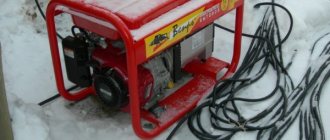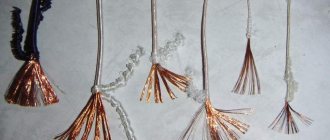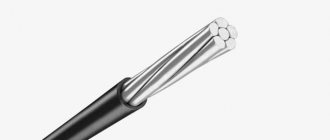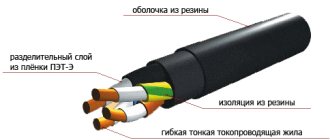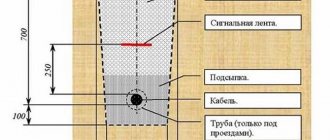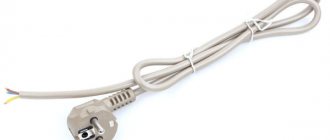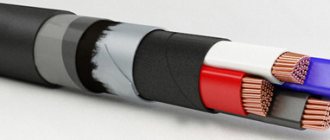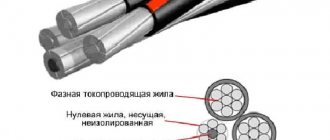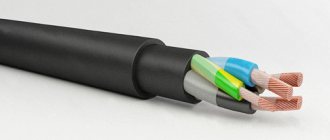Number of cores in cables
| Number of cores | Nominal cross section | ||
| main | grounding | auxiliary | main cores, mm2 |
| 1 | — | — | 2,5 — 120 |
| 2iЗ | — | — | 0,75 — 120 |
| 2&3 | 1 | — | 0,75 — 120 |
| 2&3 | — | 1 | 2,5 — 70 |
| 2&3 | — | 2 | 2,5 — 70 |
| 4&5 | — | — | 1,0-25 |
Application area
KG cables are used to connect mobile mechanisms to electrical networks. They are suitable for indoor and outdoor use. Installation underground, as well as use as a permanent connection for installations, is not allowed. The wire insulation is not designed to withstand mechanical loads. It can be damaged even from the pressure of hard soil. However, cable installation in pipes is permitted.
Subject to safety precautions, it is permissible to lay the conductor outdoors. It is able to withstand sub-zero temperatures.
KG wire is often used to connect taps, submersible pumps and welding machines.
Core cross-section, mm2
| Main veins | Grounding conductors | Auxiliary cores |
| 0,75 | 0,75 | — |
| 1,0 | 1,0 | — |
| 1,5 | 1,0 | 1,5 |
| 2,5 | 1,5 | 1,5 |
| 4,0 | 2,5 | 2,5 |
| 6,0 | 4,0 | 4,0 |
| 10 | 6,0 | 6,0 |
| 16 | 6,0 | 6,0 |
| 25 | 10 | |
| 35 | 10 | — |
| 50 | 16 | 10 |
| 70 | — | 10 |
| 95 | — | — |
| 120 | 35 | — |
| 150 | 50 | — |
The nominal insulation thickness and sheath thickness values for cables of the KG brand are indicated in the table (higher sheath thickness values apply to cables with a large number of cores). The conductors of cables of the KG brand must have digital markings or distinctive colors, while the green-yellow color of the insulation is used only for the grounding conductor.
Insulated conductors must be twisted in the right direction, and to ensure operation under given conditions, insulated conductors in KG brand cables with three main and two auxiliary conductors with a cross-section of 16 mm2 or more must be twisted around a rubber core.
To make cable cutting easier, a layer of synthetic film or other material should be placed over the twisted cores. In single-core cables of the KG brand, it is possible to replace the insulation and sheath with an insulating protective sheath. The nominal thickness of the sheath must be equal to the sum of the thicknesses of the insulation and sheath.
Reference values of outer diameters and weights of cables of the most widely produced standard sizes are indicated in the tables. Taking into account significant tolerances, actual values may differ by 10% down or up.
Characteristics
- Brand? Abbreviation (marking), as a rule, each capital letter has the meaning of a property or design. KG
- Number of cores? The power cable has from 1 to 5 cores. A cable with 1 core is used depending on the color of the core: g/h - grounding, blue (blue) - zero. white, red, black - phase colors. Cable with 2 cores used for zero and phase, 3 wires - zero, phase, 1
- Cross-section of the core (mm/sq)? Section or cut area, measured in square millimeters. The throughput of the core depends on the cross-section, in other words, how many amperes the core can carry. The larger the cross-section, the lower the resistance (Ohm). For voltage, the cross-section is 35
- Core material? Copper is the first most important core material, this is due to: 1) High electrical conductivity. 2) Sufficient mechanical strength. 3) Satisfactory corrosion resistance. Aluminum is the second most important core material according to the following points Copper
- Insulation material? PVC - polyvinyl chloride (the most common insulation material, with advantages: low fire hazard, relatively high durability in gentle conditions, with disadvantages: toxicity of combustion products.) HDPE - polyethylene (the most resistant to rubber
- Sheath material? Sheath (protective hose) - protects the insulation of the cores from external influences (mechanical, chemical, thermal, ultraviolet). Rubber
- Maximum weight (kg/m)? Weight is an estimate, actual values may vary. 0.59
- Maximum outer diameter (mm) 16.4
- Electrical resistance of the core (ohm/km) 0.55
- Allowable bending radius (mm) 131.2
- Permissible current load when laying in air (A) 270
- Rated alternating voltage (kV) 0.66
- Operating temperature range (°C) from -40 to +50
- Service life 4
- OKP code 354 441
- Fire hazard class according to GOST 31565-2012 02.8.2.5.4
- Core insulation resistance (MOhm/km) 50
- Core insulation thickness (mm) 1.4
- Weight of non-ferrous metal (g/m) 311.5
- Minimum operating temperature (°C) -40
- Maximum power when installed in air, 220V (kW) 50
- Maximum power when installed in air, 380V (kW) 92.12
- Type of execution according to GOST 31565-2012 Without designation
- GOST 24334-80
- Core class according to GOST 22483-2012 5
- Maximum core diameter 9.2
- Maximum design weight (kg/km) 590
- Long-term permissible core heating temperature 75
- Permissible traction force (N) 1050
- Permissible traction force (N) 1050
KG 1x35 - flexible copper power cable with 1 stranded cores with a cross-section of 35 millimeters square, in rubber insulation and sheath.
Thicknesses of insulation and sheaths for cables of grades KG mm
| Nominal cross-section of main cores, mm2 | Insulation | Sheath for single-core cables | Sheath for multi-core cables |
| 0,75 | 0,8 | — | 1,3- 1,5 |
| 1,0 | 0,8 | — | 1,3- 1,6 |
| 1,5 | 0,8 | — | 1,5- 1,8 |
| 2,5 | 0,9 | 1,4 | 1,7-2,0 |
| 4,0 | 1,0 | 1,5 | 1,8-2,2 |
| 6,0 | 1,0 | 1,6 | 2,0 — 2,5 |
| 10 | 1,2 | 1,8 | 3,1 -3,6 |
| 16 | 1,2 | 1.9 | 3,3 — 3,9 |
| 25 | 1,4 | 2,0 | 3,6 — 4,4 |
| 35 | 1.4 | 2,2 | 3,6 — 4,5 |
| 50 | 1,6 | 2,4 | 4,5 — 5,0 |
| 70 | 1,6 | 2,6 | 4,8 — 5,0 |
| 95 | 1,8 | 2,8 | 5,0-5,3 |
| 120 | 1,8 | 3,0 | 5,0 — 5,3 |
Explanation of marking KG 1*35
TO
- cable.
G
- flexible.
1
- number of copper stranded cores.
35
- cross-section of cores in square millimeters. The marking may also contain the following designations: (0.66) - rated voltage up to 660 Volts. (0.38) - rated voltage up to 380 Volts.
Cable design KG 1x35
1) Core - copper, multi-wire, round, fifth class according to GOST 22483. 2) Separating layer - synthetic film or talc layer. 2) Insulation – made of insulating rubber. 3) The shell is made of hose rubber.
Core colors for cables of KG brands
| Number of cores | Color without grounding conductor | Coloring with grounding conductor |
| 3 | blue, black, brown | green-yellow, blue, brown |
| 4 | blue, black, brown, black or brown | green-yellow, blue, black, brown |
| 5 | blue, black, brown, black or brown, black or brown | green-yellow, blue, black, brown, black or brown |
| 6 | — | green-yellow, black, blue, black, brown, black |
Outer diameters of cables, mm
| Nominal cross-section of main cores, mm2 | Single-core | With three main conductors and a grounding conductor |
| 0,75 | — | 10 |
| 1,0 | — | 10 |
| 1,5 | — | 11 |
| 2,5 | 7,0 | 13 |
| 4,0 | 8,0 | 16 |
| 6,0 | 9,0 | 18 |
| 10 | 10 | 23 |
| 16 | 13 | 25 |
| 25 | 15 | 30 |
| 35 | 17 | 35 |
| 50 | 19 | 42 |
| 70 | 22 | 45 |
| 95 | 24 | 51 |
| 120 | 27 | 56 |
| 150 | — | — |
Cable design features
Let's consider all the components of the cable:
- A conductor consisting of numerous copper wires of round cross-section. In the process of manufacturing cores for CG cables, they are guided by GOST standards. For use in tropical climates, special “T” cores are produced: in addition to copper, tin is added to them. Alternatively, copper can be coated with a lead-tin layer, and the content of the first metal in the alloy must be at least 40%.
- All cores are hidden under a common film made of synthetic material. It acts as a separator.
- For insulation, special vulcanized rubber is used, and the coating is painted in a color that matches the purpose of the core. For example, blue is chosen for the neutral, yellow-green for the grounding circuit, etc. Instead of being completely painted, all the cores can be white with stripes of the desired color. In the absence of a neutral conductor, a blue stripe is applied to any other conductor with the exception of yellow-green. In addition to coloring, a symbolic designation can be used (for neutral - “0”). Wires with one or two cores usually do not have a strict coloring. The phase is often indicated by brown or black.
- All conductors are twisted together with a certain pitch. In the KG cable, the interval is 16 diameters, taking into account the insulating layer.
- After this, a second separation layer is placed. Again, a film of synthetic material is taken, with which the twisted conductors are covered. For example, this could be a microtalc product. In case of separation of cores from the sheath, the separating film is not used.
- The outer insulating layer is made of butadiene rubber. For wires with one core, instead of using different insulations for the core and the cable as a whole, a single protective sheath can be used. The thickness will be identical to two layers.
Cable weights, kg/km
| Nominal cross-section of main cores, mm2 | Single-core | With three main conductors and a grounding conductor |
| 0,75 | 140 | |
| 1,0 | — | 150 |
| 1,5 | — | 190 |
| 2,5 | 70 | 280 |
| 4,0 | 100 | 390 |
| 6,0 | 130 | 540 |
| 10 | 210 | 910 |
| 16 | 290 | 1200 |
| 25 | 420 | 1700 |
| 35 | 560 | 2300 |
| 50 | 760 | 3100 |
| 70 | 1000 | 4100 |
| 95 | 1300 | 5300 |
| 120 | 1600 | 6300 |
| 150 | — | — |
KG-HL
View prices →
Description
The KG-HL cable is a power cable with stranded copper cores and rubber insulation. The sheath made of cold-resistant rubber allows the KG-HL cable to be used at temperatures down to -60 C. It is resistant to solar radiation. The cable is intended for the transmission and distribution of electrical energy in installations with a rated alternating voltage of 380 V, frequency up to 400 Hz, or a constant rated voltage of 660 V.
KG-HL cable design:
- Current-carrying conductor twisted from copper wires (class 5);
- A layer of PET-E polyethylene terephthalate film;
- Rubber insulation type RTI-1-HL based on natural and butadiene rubbers.
- — digital marking: 1, 2, 3, 4, 5, grounding conductor — 0,
- — color marking: blue, black, brown, grounding conductor — green-yellow;
- A layer of PET-E polyethylene terephthalate film (on top of twisted insulated cores);
- Sheath made of rubber type RSHTM-2-KhL based on isoprene and butadiene rubbers; insulating and protective sheath of single-core cables made of rubber type RTISH-KhL based on isoprene and butadiene rubbers.
Explanation of KG-HL:
K - cable G - flexible HL - climatic version - cold-resistant (from -60 C to +50 C)
Characteristics
Conditions for laying and operating the KG-HL cable:
The cable is intended for use on land, rivers and lakes in macroclimatic areas with moderate and cold climates, outdoors and indoors.
Repeated bending of the cable through the roller system:
| Roller diameter | Tensile load | Section of main cores | Number of bending cycles |
| 120 mm | 15 N | 2.5 sq.mm | 30 000 |
| 200 mm | 20 N | 4.0 sq.mm | 30 000 |
Multiple cable bends at an angle ±P/2 rad with a tensile force of 49 N:
| Roller diameter | Section of main cores | Number of bending cycles |
| 200 mm | from 6.0 to 16 sq. mm | 90 000 |
| 200 mm | from 25 to 50 sq.mm | 60 000 |
| 400* mm | from 70 to 120 sq.mm | 40 000 |
* for single-core cables, the roller diameter should be no more than 200 mm.
Technical characteristics of the KG-HL cable:
| Warranty period | 6 months |
| Long-term permissible temperature on the core, no more | 75°C |
| Test alternating voltage with a frequency of 50 Hz, 5 min. | 2.5kV |
| Maximum operating temperature of the core | 75°C |
| Rated alternating voltage frequency 400 Hz | 0.66 kV |
| Rated DC Voltage | 1 kV |
| Cable bending radius | 8 bunk diameters |
| Tensile force of cables per 1 sq. mm. total cross-section of all cores, no more | 19.6 N |
| Construction length, not less | 150 m |
| Ambient temperature, upper limit | 50°C |
| Ambient temperature, lower limit | -60°C |
| Electrical insulation resistance of main cores at 20°C, not less | 50 MOhm x km |
Group characteristics
Flexible power cables
This group includes cables with copper stranded conductors with rubber insulation in a rubber sheath, intended for power supply to mobile consumers and for non-stationary installation.
Brands and scope
| Cable brand | GOST, TU | Application area |
| KG kg-hl kg-t kg kgn kpg kpgs kpgsn | TU 16.K73.05-93 | For connecting mobile mechanisms to electrical networks for rated alternating voltage up to 660 V with a frequency of up to 400 Hz or direct voltage up to 1000 V |
| KOG-1 | TU 16.K73.03-88 | For connection during arc welding of electric holders of welding installations with a rated voltage of 220 V AC with a frequency of 50 Hz or DC |
| KGE | TU 16.K73.02-89 | For connecting excavators and other mobile machinery to electrical networks with a rated voltage of 6 kV AC with a frequency of 50 Hz. |
| KShVGT-10 | TU 16-705.101-79 | For stationary and mobile installation and connection of mobile mechanisms to electrical networks with a rated voltage of 10 kV AC with a frequency of 50 Hz |
Designs and operating conditions
| Cable brand | Design | terms of Use |
| KG | Basic (with copper stranded conductors with rubber insulation in a rubber sheath) | For bends with a radius of at least 8 cable diameters, at ambient temperatures from -40 to +50°C when exposed to solar radiation |
| KG-HL | Using cold climate tires | The same, at ambient temperatures from -60 to +50°C |
| KG-T | With tinned copper wires and rubber for tropical climates | The same, at ambient temperatures from -10 to +55°C, with resistance to mold fungi |
| KGN | In an oil-resistant, flame-retardant shell | When bending with a radius of at least 8 cable diameters, with the possibility of oil getting on the sheath, at an ambient temperature from -30 to +50°C |
| CNG | With highly flexible cores | For bends with a radius of at least 5 cable diameters, at ambient temperatures from -50 to +50°C when exposed to solar radiation |
| CPGS | With highly flexible cores and profiled core | The same, if the cable can be exposed to shock and crushing loads |
Number of cores in cables
| Cable brand | Number of cores | Nominal cross section | ||
| main | grounding | auxiliary | main cores, mm2 | |
| KG, KG-T and kg-hl, kg | 1 | — | — | 2,5 — 120 |
| 2iЗ | — | — | 0,75 — 120 | |
| 2&3 | 1 | — | 0,75 — 120 | |
| 2&3 | — | 1 | 2,5 — 70 | |
| 2&3 | — | 2 | 2,5 — 70 | |
| 4&5 | — | — | 1,0-25 | |
| CNG | 2 | — | — | 0,75 — 70 |
| 2&3 | 1 | — | 0,75 — 70 | |
| KPGSi kgpsn | 3 | 1 | — | 2,5 — 120 |
| 3 | 1 | 1 | 2,5 — 6,0 | |
| 3 | 1 | 2 | 4,0 — 50 | |
| KOG-1 | 1 | — | — | 16- 150 |
| KGE | 3 | 1 | — | 10- 150 |
| 3 | 1 | 1 | 10- 150 | |
| KShVGT-10 | 3 | 3 | — | 25 — 150 |
Core cross-section, mm2
| Main veins | Grounding conductors | Grounding conductors for KShVGT-10 | Auxiliary cores |
| 0,75 | 0,75 | — | — |
| 1,0 | 1,0 | — | — |
| 1,5 | 1,0 | — | 1,5 |
| 2,5 | 1,5 | — | 1,5 |
| 4,0 | 2,5 | — | 2,5 |
| 6,0 | 4,0 | — | 4,0 |
| 10 | 6,0 | — | 6,0 |
| 16 | 6,0 | — | 6,0 |
| 25 | 10 | 6,0 | 10; b.O for KGE |
| 35 | 10 | 6,0 | 10; b.O for KGE |
| 50 | 16 | 10 | 10 |
| 70 | 25, 16 for KGE | 10 | 10 |
| 95 | 35, 25 for KGE | 16 | 10 for KGE |
| 120 | 35 | 16 | 10 for KGE |
| 150 | 50 | 25 | 10 for KGE |
The nominal insulation thickness and sheath thickness values for cables of the KG, KG-HL, KG-T, KGN, KPG, KPGS, KPGSN brands are indicated in Table 4.2.3-3 (higher sheath thickness values apply to cables with a large number of cores) . Cable cores of brands KG, KG-HL, KG-T, KGN, KPG, KPGS, KPGSN must have digital markings or distinctive colors indicated in Table 4.2.3-4, while green-yellow insulation color is used only for the grounding core. The nominal thicknesses of insulation and sheaths for cables of the KOG-1 brand are given in Table 4.2.3-5, the nominal thicknesses of structural elements for cables of the KGE brand are given in Table 4.2.3-6, the nominal thicknesses of structural elements for cables of the KShVGT-10 brand are given in the table 4.2.3-7. The color of insulation for cables of the KOG-1 and KGE brands is not standardized; in cables of the KShVGT-10 brand, the main cores can have any color except black.
Insulated conductors must be twisted in the right direction, and to ensure operation under given conditions, insulated conductors in cables of the KG, KGN brands with three main and two auxiliary conductors with a cross-section of 16 mm2 or more, cables of the CPG brand with four conductors of 16 mm2 or more must be twisted around the rubber core, and in cables of the KPSG and KPSGN brands with four cores with a cross-section of 16 mm2 or more, five- and six-core all sections must be twisted around a round or profiled rubber core. In cables of the KShVGT-10 brand, all insulated cores must be twisted with a core made of electrically conductive rubber in the center, and the shell is made of two layers with an inner layer of electrically conductive rubber.
To make cable cutting easier, a layer of synthetic film or other material should be placed over the twisted cores. In cables of the KOG-1 brand and single-core cables of the KG brand, it is allowed to replace the insulation and sheath with an insulating protective sheath. The nominal thickness of the sheath must be equal to the sum of the thicknesses of the insulation and sheath.
Reference values for the outer diameters and masses of cables of the most widely produced standard sizes are indicated in Tables 4.2.3-8 and 4.2.3-9, respectively. Taking into account significant tolerances, actual values may differ by 10% down or up.
Cross section of KGE brand cable
1. Grounding conductor; 2. Main core with an electrically conductive element; 3. Insulation; 4. Electrically conductive insulation screen; 5. Belt screen made of electrically conductive rubber; 6. Auxiliary insulated core; 7. Shell.
Insulation and sheath thicknesses for cables of brands KG, KG-HL, KG-T, KGN, KPG, KPGS, KPGSN, mm
| Nominal cross-section of main cores, mm2 | Insulation | Sheath for single-core cables | Sheath for multi-core cables |
| 0,75 | 0,8 | — | 1,3- 1,5 |
| 1,0 | 0,8 | — | 1,3- 1,6 |
| 1,5 | 0,8 | — | 1,5- 1,8 |
| 2,5 | 0,9 | 1,4 | 1,7-2,0 |
| 4,0 | 1,0 | 1,5 | 1,8-2,2 |
| 6,0 | 1,0 | 1,6 | 2,0 — 2,5 |
| 10 | 1,2 | 1,8 | 3,1 -3,6 |
| 16 | 1,2 | 1.9 | 3,3 — 3,9 |
| 25 | 1,4 | 2,0 | 3,6 — 4,4 |
| 35 | 1.4 | 2,2 | 3,6 — 4,5 |
| 50 | 1,6 | 2,4 | 4,5 — 5,0 |
| 70 | 1,6 | 2,6 | 4,8 — 5,0 |
| 95 | 1,8 | 2,8 | 5,0-5,3 |
| 120 | 1,8 | 3,0 | 5,0 — 5,3 |
Colors of cores for cables of brands KG, KG-HL, KG-T, KGN, KPG, KPGS, KPGSN
| Number of cores | Color without grounding conductor | Coloring with grounding conductor |
| 3 | blue, black, brown | green-yellow, blue, brown |
| 4 | blue, black, brown, black or brown | green-yellow, blue, black, brown |
| 5 | blue, black, brown, black or brown, black or brown | green-yellow, blue, black, brown, black or brown |
| 6 | — | green-yellow, black, blue, black, brown, black |
Insulation and sheath thicknesses for KOG-1 cables, mm
| Nominal cross-section of main cores, mm2 | Internal and external screens for core and insulation | Insulation | Belt screen | Shell |
| 10-50 | 0,4 | 4,0 | 1,5 | 3,5 |
| 70-150 | 0,6 | 4,0 | 2,0 | 4,0 |
Thicknesses of structural elements for cables of the KShVGT-10 brand, mm
| Nominal cross-section of main conductors, mm2 | Internal screen along the core | Insulation | External insulation screen | Inner shell | Outer shell |
| 25-70 | 0,8 | 6,0 | 1,0 | 3,0 | 5,0 |
| 95-150 | 1,2 | 6,0 | 1,0 | 3,0 | 6,0 |
Electrical Requirements
For the period of acceptance and delivery, cables of the KG, KG-HL, KG-T, KGN, KPG, KPGS, KPGSN brands must withstand an alternating voltage test for 5 minutes without immersion in water, and single-core cables and cables of the KOG-1 brand after being in water 2.5 kV with a frequency of 50 Hz. Cables of the KGE brand must withstand a voltage test of 15 kV, and cables of the KShVGT-10 brand - 20 kV alternating current with a frequency of 50 Hz for 5 minutes.
The electrical insulation resistance under normal climatic conditions, recalculated per 1 km of cable, upon acceptance and delivery must be at least 50 MΩ, for cables of the KShVGT-10 brand, at least 100 MΩ.
Outer diameters of cables, mm
| Nominal cross-section of main cores, mm2 | Single-core brands KG, KG-HL, KG-T | With three main conductors and a grounding conductor of brands KG, KG-HL, KG-T, KGN | With three main conductors and a grounding conductor of the CNG brand | With three main conductors and a grounding conductor of brands KPGS, KPGSN | KOG-1 | KGE | KSHVGT - 10 |
| 0,75 | — | 10 | 10 | — | — | — | — |
| 1,0 | — | 10 | 10 | — | — | — | — |
| 1,5 | — | 11 | 11 | — | — | — | — |
| 2,5 | 7,0 | 13 | 13 | 16 | — | — | — |
| 4,0 | 8,0 | 16 | 16 | 18 | — | — | — |
| 6,0 | 9,0 | 18 | 19 | 22 | — | — | — |
| 10 | 10 | 23 | 24 | 25 | — | 41 | — |
| 16 | 13 | 25 | 28 | 30 | 10 | 44 | — |
| 25 | 15 | 30 | 32 | 34 | 12 | 46 | 67 |
| 35 | 17 | 35 | 38 | 38 | 14 | 50 | 72 |
| 50 | 19 | 42 | 44 | 45 | 16 | 54 | 74 |
| 70 | 22 | 45 | 49 | 49 | 18 | 63 | 79 |
| 95 | 24 | 51 | — | 53 | 20 | 67 | 86 |
| 120 | 27 | 56 | — | 58 | 23 | 72 | 91 |
| 150 | — | — | — | — | 25 | 78 | 97 |
Cable weights, kg/km
| Nominal cross-section of main cores, mm2 | Single-core brands KG, KG-HL, KG-T | With three main conductors and a grounding conductor of brands KG, KG-HL, KG-T, KGN | With three main conductors and a grounding conductor of the CNG brand | With three main conductors and a grounding conductor of brands KPGS, KPGSN | KOG-1 | KGE | KSHVGT - 10 |
| 0,75 | 140 | 140 | — | — | |||
| 1,0 | — | 150 | 150 | — | — | — | — |
| 1,5 | — | 190 | 190 | — | — | — | — |
| 2,5 | 70 | 280 | 280 | 310 | — | — | — |
| 4,0 | 100 | 390 | 400 | 430 | — | — | — |
| 6,0 | 130 | 540 | 570 | 600 | — | — | — |
| 10 | 210 | 910 | 990 | 1100 | — | 2000 | — |
| 16 | 290 | 1200 | 1300 | 1400 | 240 | 2300 | — |
| 25 | 420 | 1700 | 1900 | 2000 | 320 | 2900 | 4900 |
| 35 | 560 | 2300 | 2600 | 2600 | 440 | 3500 | 5800 |
| 50 | 760 | 3100 | 3600 | 3700 | 610 | 4100 | 6700 |
| 70 | 1000 | 4100 | 4800 | 4800 | 840 | 5600 | 7900 |
| 95 | 1300 | 5300 | — | 5500 | 1100 | 6900 | 9700 |
| 120 | 1600 | 6300 | — | 6500 | 1400 | 8100 | 11000 |
| 150 | — | — | — | — | 1700 | 9600 | 13000 |
← Back

